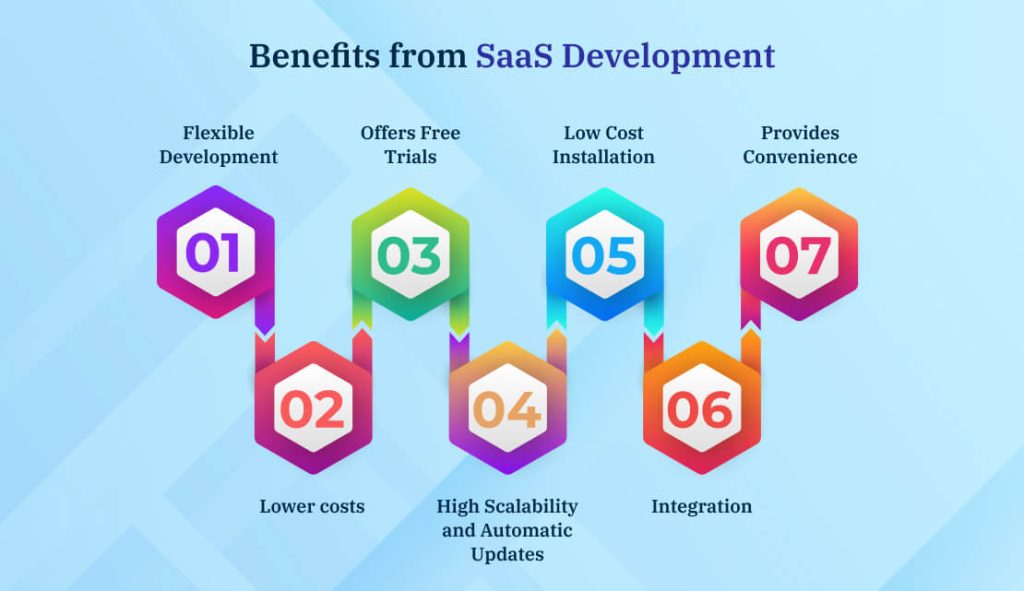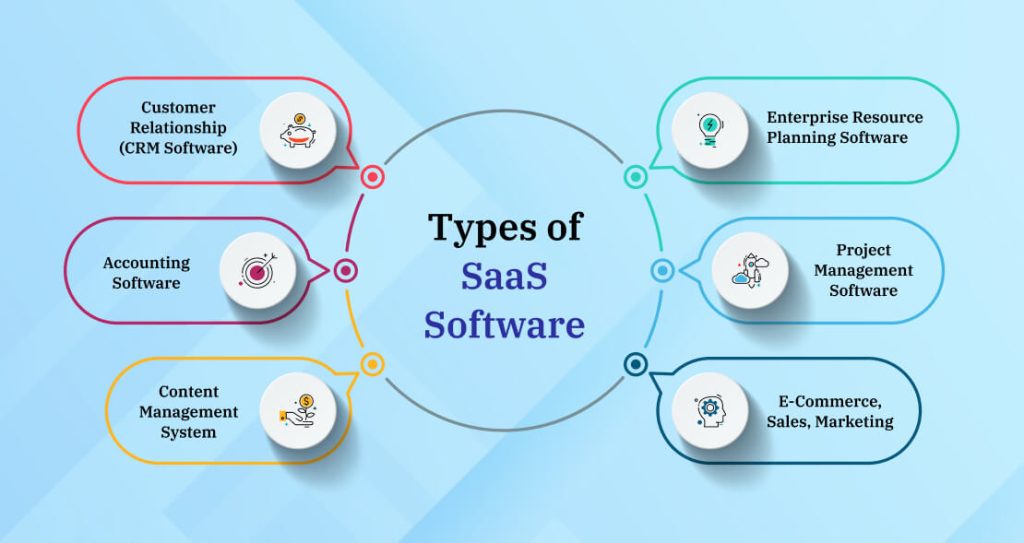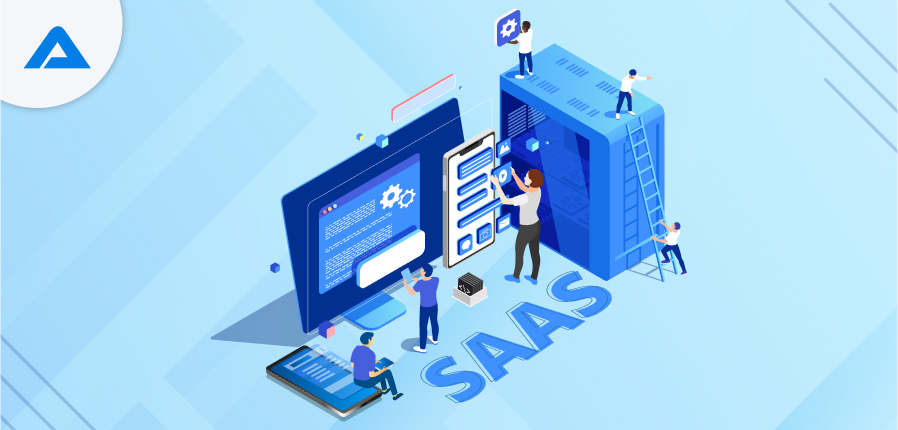Businesses are always looking for new ways to get ahead of their competitors in the digital age. Software as a Service is one way to achieve this. SaaS applications have become increasingly popular over the past few years. They have many advantages over traditional software. These include, but are not limited to: being easier to use and requiring less setup time. Direct dealings with a single system provider also increase security.
SaaS is a growing trend in business. More businesses are implementing it into their work environment.
It is difficult to understand the benefits of SaaS development and how it can be developed without understanding the technology. SaaS can be accessed through any browser and any device that has an Internet connection. However, as with all technologies, it is not without its nuances.
What is SaaS (Software as a Service)?
with a web-browser and an internet connection. In this web-based architecture, software providers host and maintain the servers, databases and code that comprise an application.
This means that as long as you have an internet connection, you can access it anywhere. This means that users are able to use an app while developers continue to work on updating it.
SaaS applications are accessible because of the cloud architecture. SaaS programs are developed and deployed in the cloud, whether it is private or public.
Difference Between SaaS Software and Traditional Software
Here’s a quick summary of the differences between traditional app development and SaaS:
- SaaS, on the other hand, is hosted by the cloud. A traditional software application is stored on the hardware and dedicated servers of the user or client.
- Businesses and customers can “rent” the SaaS by paying subscription fees as long as they want. However, legally acquired software is a user’s tangible asset. It’s often purchased with an upfront fee.
- SaaS can be as large as the user requires in terms of scope and functionality, as there are no restrictions on storage. This problem is not experienced by other applications or apps, as they consider the RAM of the device.
Why is SaaS So Popular?
SaaS is a good distribution model, regardless of the trends. It offers a lot of value, especially in today’s economic climate, when companies are looking to reduce costs and streamline their operations.
Companies of all sizes, prompted by the pandemic and its effects, are now using SaaS to improve their efficiency and collaborate across different locations. The increased demand for SaaS has led to the rapid development of new SaaS product development. These new solutions are user-centric, have a wide range of connectivity, and can be accessed and used online. According to current SaaS trends, these solutions are easy to use, understand and subscribe to, making them accessible to those outside the IT department.
SaaS is a very popular solution for companies that want to prevent a data breach. This type of software, which is hosted by a solution provider and updated regularly, has become an industry standard.
Benefits from SaaS Development

SaaS has gained in popularity over the past few years as more and more businesses have sought to benefit from their benefits. SaaS applications offer a number of advantages over traditional software on premises, such as lower costs, easy deployment and maintenance and increased flexibility.
The lower cost is one of the most important advantages of using SaaS applications. SaaS applications tend to be subscription-based. This means you only pay what you use. You don’t need to buy expensive software or hardware licences and can adjust your usage as you see fit. Businesses can save a lot of money by using cloud-based solutions instead of traditional on-premise ones.
Flexible Development
SaaS applications allow you to adapt your system in order to meet changing needs. A developer can take several months to update conventional software. SaaS applications are developed in the cloud. This makes it much easier to change. You can also build a similar system without having to spend money on additional hardware. Alternatively, the consumer can test it anywhere with an Internet connection.
Lower costs
SaaS is a cost-saving option because it’s usually in a shared environment. The hardware and software licensing costs are lower than the traditional model.
SaaS also allows you to rapidly expand your customer base, as it allows small and mid-sized businesses to access software they otherwise wouldn’t use because of the high licensing costs.
The SaaS provider is responsible for the maintenance costs, which are split between all users of the solution.
Offers Free Trials
SaaS makes it simple for software providers to provide free trials. Customers can try out a software program for seven, fourteen or thirty days to decide if they want to subscribe.
It is often beneficial for potential buyers to be able test a product prior to investing in it. This minimizes the risk and maximizes returns on investment. A free trial allows consumers to determine if the product meets their needs. Businesses that offer this service can increase their leads and customer base.
High Scalability and Automatic Updates
All users can instantly download updates and upgrades. You can improve your app’s functionality and security in the background, without disrupting client operations. SaaS apps are also highly scalable, and they grow with your business. Regularly, new features and benefits are added.

Low Cost Installation
Software-as-a-service providers offer subscription plans to help businesses get online quickly. SaaS providers may allow businesses to customize a subscription to suit their business needs. However, the cost of these changes can be higher. Even if premium features are added to a SaaS plan, businesses will still save money. This is because maintaining and installing software or IT assets for business is more expensive than SaaS plans.
Integration
SaaS solutions are usually hosted in cloud environments. These environments can be scalable and integrate with other SaaS services. You don’t need to purchase another server or piece of software, unlike the traditional model. The SaaS provider is responsible for planning server capacity and will only require you to enable the new SaaS service. You’ll also have the option to adjust your SaaS usage based on your specific needs.
Provides Convenience
SaaS software development can be convenient for customers, as the provider manages IT development. Customers can access functional, up-to date applications by simply connecting to the Internet and signing in. Instant, easy access to applications saves clients time and effort.
Types of SaaS Software

The key aspect of the software-as-a-service model is that every business can tailor its choice of software and features to its strategy and needs. SaaS software companies offer a variety of building blocks that cover all business needs, while others focus on specific lines of business.
Here are some of the most popular types of software you can offer as a SaaS provider to small and mid-sized businesses (and/or to streamline your own internal operations).
Customer Relationship (CRM Software)
It’s crucial to support the revenue-generating processes that are at the core of any business when building SaaS CRM.
It should have all the features required, including user management, access controls, canned responses, integrations with customer support centers and knowledge bases, and many more. It must also offer flexible business rules editors to allow the creation of bespoke workflows.
Enterprise Resource Planning Software
SaaS ERP is the software that organizations use to manage their daily business processes. This includes everything from internal training and accounting, to procurement and logistics. It must therefore be able to download data from any source, process it and then upload the results to various destinations in different formats.
Data analytics, scheduling and automation of paperwork, notifications and reminders and task management are all important functions.
Accounting Software
SaaS software for accounting is vital to keep track of income and expenses, and ensure a stable cash flow.
The key features required are general ledgers and a chart account, as well as transaction recording, accounting management, invoicing, calculation of tax, and reconciliation of accounts. Some of these features can be included in a subscription package while others require API integration.
Project Management Software
SaaS software for project management is essential to keep track of tasks and staff, as well as evaluate the efficiency of resource allocation.
It must integrate with external sources such as Dropbox and GitHub for the storage of code repositories and attachments. It should also be able to integrate with email and calendar systems in order to track progress and time.
Content Management System
SaaS CMS software manages how a business interacts and engages its audience. This includes blog articles, landing pages, testimonials and banners.
It must therefore include features like a WYSIWYG or HTML editor, the ability to process media, post-scheduling and integration with Google Analytics, among others.
E-Commerce, Sales, and Marketing
The features and solutions are numerous, but it is hard to underestimate them. All businesses selling online use some form of SaaS-based ecommerce platform or marketing/sales tool. The only way to convince clients to switch is to provide functionality that competitors do not offer.
The Key Challenges in SaaS Application Development
SaaS is used by businesses around the world for their entire operations. This includes Accounting, Invoices and Emailing. SaaS development is a logical investment. SaaS development is not without its challenges. We don’t build SaaS to be used by a specific or particular organization, but rather for a variety of organizations. The challenges are in delivering applications to users. Here are the most common technical and general challenges that you will face when developing your SaaS app.
Managing Scalability & Performance
In Software-as-a-Service (SaaS), SaaS development services revolutionizes how businesses access software. SaaS systems do not require intensive device maintenance like traditional systems. They only need an internet connection.
SaaS companies are focused on performance and scalability, starting with the ideation process to choosing a robust SaaS framework. SaaS applications are characterized by their ability to improve iteratively based on analytics and feedback.
Zero downtime deployment strategies are essential for maintaining a competitive advantage. A methodical approach can help navigate the complexity of scaling and performance, even with the challenges that SaaS development presents, like data inconsistency.
SaaS applications often handle sensitive data. Data security is therefore paramount. Businesses can boost their efficiency and sustainability by switching from traditional ERP software models to SaaS, which is a competitive SaaS model.
Integration of Third-Party Payment
Payment functionality is a vital part of any SaaS. It is usually achieved by integrating the system with a payment service from a third party. Integration can be done in two ways: The easy way or the demanding one. Easy is a payment system that offers great integration support. The more difficult one is more complex, as the team must examine technical challenges and aspects behind the payment integration, and then create appropriate web application solutions components such as services or facades in order to seamlessly integrate the external service.
Standard payment solutions expose libraries that are already necessary to integrate. We have implemented PayPal, Secure Trading QuickPay, Skrill, Braintree or Skrill, among others, on many projects.
It is essential that the development team develops automated and manual testing to make sure the payment integration is working properly.
Hybrid Infrastructure
SaaS and on-premises solutions don’t always go together. Integration of on-premises solutions with cloud-based ones can be a difficult task for businesses, negating the benefits that come with hybrid technologies. To ensure seamless integration, the service provider and IT staff must work closely together.
Even though many SaaS vendors offer integration services, IT managers must take the necessary steps to ensure seamless system integration. Cloud consulting firms can be very helpful if your solution provider doesn’t offer integration services, or if you have trouble integrating on your own.
Access control
Another challenge businesses face is access control when they move to the cloud. This is mainly due to the fact that monitoring settings and access controls do not always transfer smoothly from traditional software into a SaaS-based solution. Administrators must have full control over access to what and who, but sometimes they may not be aware of it, especially when transitioning.
Free trial users that don’t convert
Unfortunately, not every user who tries out a free trial will become a paying customer. SaaS businesses can suffer a huge loss if this happens. Free trial users who do not convert are usually due to a number of reasons, including your product not being up to expectations, your customers not understanding why your product is special, or your pricing model.
Communication is key to solving these problems. Transparency is key. Share all positive and valuable feedback received by your product. Communicate with your customers what makes your products unique and why you think they should buy your service. Show them what your products can do for them.
Try out different price points and see which works best for you. Test different tiers of plans to see which are the most successful. Track everything, from conversion rates and churn to average deal sizes and life-time value.
The Key Takeaway
What is SaaS, then? SaaS is software that users can access and use from anywhere. This type of software can be tailored to your company’s needs, and because it is cloud-based, there’s no need to install updates or make room on your computer for additional software.
It’s not difficult to build a SaaS-based product by partnering with a reliable SaaS development company nearby. You can help your customers close more sales by providing them with eight benefits once your product is on the market. These include making it easy to use, affordable and secure.
Cloud services will grow in importance as more businesses abandon traditional software models. What does this mean to you? SaaS is the way to go if you want to keep up with the times.
FAQs
SaaS and traditional software are very different in terms of cost and delivery. SaaS is a subscription model that’s delivered via the internet. Traditional software, on the other hand, usually requires upfront costs and physical installations.
SaaS applications offer many benefits. These include automation, third-party database integration, enhanced security, and high compatibility. This requires a lot of expertise and dedication. With the right partner your app development will be easier.
- Idea generation and Validation
- UX/UI Design
- Development and Testing
- Product Launches and Maintenance
- Product Scaling
Research the market and learn more about your target audience’s needs. Write a business proposal to describe the business model and marketing techniques. Select the core functionality and technical stack. Build an MVP and get feedback from users.
It should not have extra complicated functionality that could confuse users. It shouldn’t have any extra complex functionality that could confuse users. Its workflow must be transparent and clear. A good SaaS should protect and secure user data.

Hire our nearshore devs to build and run your SaaS application to scale your company.

Pooja Upadhyay
Director Of People Operations & Client Relations

